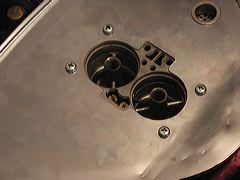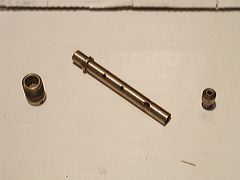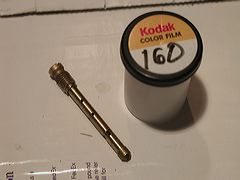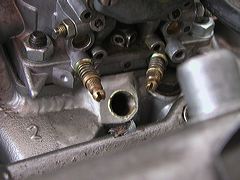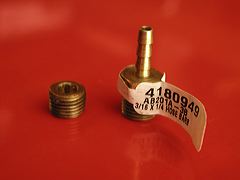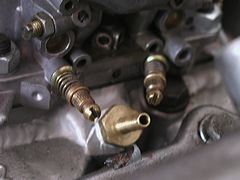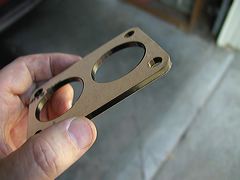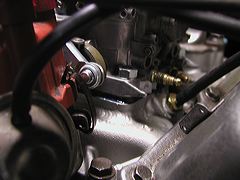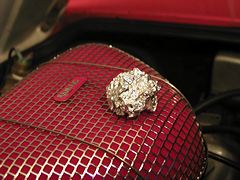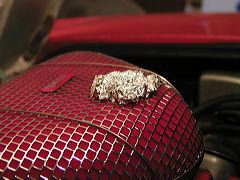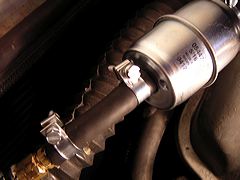|
|
The air filter that comes with the kit is designed so that you don't need to remove the baseplate to change the jets. |
|
|
One problem I found in my early test drives was "lean surge" -- at constant highway speeds, the car's speed varied slightly, as if I were jiggling my foot on the accelerator pedal. This is a classic sign of an engine that's running too lean. I called MSS and discussed this with Jack Lawrence, designer of the kit, and he sent me a pair of slightly larger main jets to make the fuel mixture a bit richer at highway speeds. Here, I've taken the jet assembly apart (it just slips together, but it's a tight fit) and am ready to install the new jet at right by slipping it into the end of the emulsion tube. |
|
|
Here's the assembly back together with the new jet in place. I've put the previous jets into a 35mm film can and labelled it so I'll remember which are which. The 160 jets (in the can) are the ones that were causing the lean surge; I tried a 165, and eventually settled on a 170 to solve the problem. |
|
|
Another problem, one that most people won't have: I have a cruise control installed on my Sonett, and the cruise control unit's servo is powered by engine vacuum. That meant I needed to find a place on the new manifold to connect it. Fortunately, the MSS manifold comes with a capped vacuum fitting, which I believe is intended for hooking up the power brake booster on the model 96. Using a hex key, I unscrewed the cap, revealing this hole into the manifold. |
|
|
A quick trip to the hardware store yielded this hose fitting with 3/16" threads that match those of the original cap (seen at left.) |
|
|
The new fitting screws into the hole, and now I have place to hook up my cruise control vacuum line. I used teflon pipe tape on the threads to assure a good seal. |
|
|
After a week or so of experience with the induction kit, I found more drivability issues that took some sorting out. One was a stumble when driving at part-throttle in the 2000-3000 rpm range. Another call to MSS suggested changing the float level from the original 50mm to 48mm. You adjust this level by removing the top from the carb and holding it vertically so the tab on the float JUST BARELY touches the needle valve. Then you measure the distance from the inside edge of the cover to the bottom of the float. To adjust the distance, you bend the tab by a TINY amount. The proper way to make the measurement is with a metric caliper; I was able to get it using a steel rule, but that makes it much harder to be sure you're correct. |
|
|
I also found that on very hot days, it was a bit difficult to restart the car if I shut it off after the engine was fully warmed up. My theory was that heat from the engine was being conducted up through the carb base and making the fuel bubble up in the float bowl. This 4mm-thick phenolic insulator is available from Pierce Manifolds; I ordered one and found that it helped quite a bit. I believe MSS now is including a similar insulator with the kit. |
|
|
Four millimeters isn't much -- but then again, the underhood space in a Sonett is VERY tight! I was afraid that even the small extra thickness added by the insulator (visible here at the base of the carb) might not leave enough space for the air filter to clear the engine lid. So, I tried my semi-scientific "tinfoil test." |
|
|
To do this, you take a small piece of aluminum foil and crumple it loosely into a ball. Put the ball on top of the air filter, then close the engine lid. |
|
|
After opening the lid again, you can measure the thickness of the now-crushed ball of foil and see how much clearance you have. A measurement here showed that I've still got almost 3/4" of clearance -- not much, but enough. |
|
|
MSS recommends a metal fuel filter. Also, I learned the hard way to use skookum fuel-line clamps (note solid band) to secure the rubber line -- generic worm-drive clamps may not grip firmly enough, and can cut into the hose if you tighten them too much trying to get them to hold.
Since solving these problems, the MSS system has been trouble-free and reliable. I still get a slight stumble when going through about 3000 rpm at certain throttle openings -- this suggests the idle circuit (which controls both idling and low-range running on a DCNF) may still be a bit lean. Going up one size on the idle jets might fix it, but I want to be sure I have a solid handle on the problem before I start experimenting further. When troubleshooting things such as a carburetor installation, it's always best to follow the scientific method and change only one thing at a time! |
